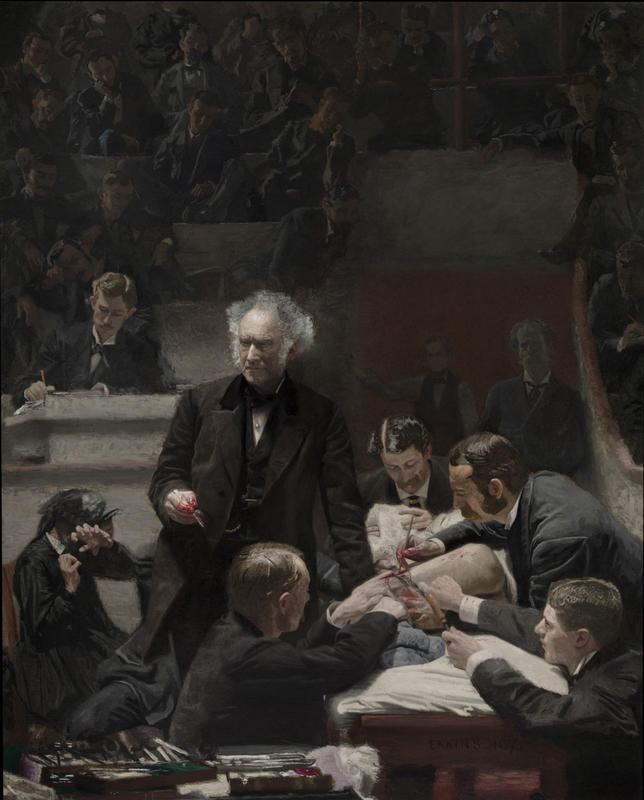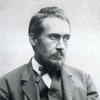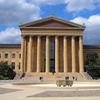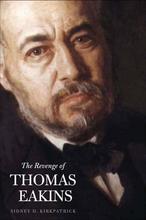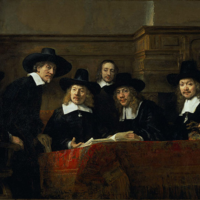More about Portrait of Dr. Samuel D. Gross (The Gross Clinic)
- All
- Info
- Shop

Sr. Contributor
Surgery is pretty gross, but not when you have Dr. Samuel D. Gross at the helm.
It takes a special kind of person to deal with the blood, guts, and stress of opening up a person’s body. Even though it’s just a painting of something only mildly gross, many people who saw this painting for the first time when it debuted in 1876 felt this same sense of repulsion.
The titular “Gross” identifies Dr. Samuel D. Gross, who was an incredibly famous surgeon and teacher from Thomas Eakins’s own Philadelphia and was known as “The Emperor of American Surgery” during his time in the mid to late 1800s. Gross was a pioneer of the early field of anatomical surgery and devised many of his own types of surgeries that later became standard practice. Here, we see Gross operating on a patient with an infected thigh bone, and thanks to his genius, Gross was able to save the leg from amputation. Eakins, who was actually a student of Gross while attending Jefferson Medical College, painted portraits of those he admired, and Gross was no exception. To further highlight Eakins’s admiration for the surgeon, Eakins placed an easter egg in the painting. The figure seated to the right of the amphitheater’s railing and either sketching or taking notes is a self-portrait of the artist as one of Gross’s diligent students.
But this ain’t no episode of Grey’s Anatomy we’re dealing with here, and, while the genius of Shonda Rhimes’s medical drama cannot be denied, The Gross Clinic was nowhere near as well-received as its twenty-first century counterpart. Eakins painted this powerful and imposing portrait of Dr. Gross doing his surgical thing for the 1876 Centennial Exhibition in Philadelphia. Eakins hailed Gross as one of the heroes of modern life, and he hoped that showing Gross in the midst of a life-changing surgery would represent the late-nineteenth century’s innovations in science and medicine in America and, specifically, in Philadelphia.
Sadly, the general public didn’t really understand what Eakins was going for in this monumental and slightly gory portrait. The blood on Gross’s gloves and scalpel, combined with the patient’s open wound, proved to be just too much to handle, and contemporary viewers were shocked by the painting’s realistic depiction of something that wasn’t very pleasant to look at. The painting, now considered to be a masterpiece of American painting, was ultimately denied from being shown with the other artworks submitted to the Centennial Exhibition and was relegated to the area of the fair that displayed medical exhibitions. After the exhibition, Jefferson Medical College alumni purchased the painting in 1878 for a mere $200 so that it could be put on display at the college, where it hung for more than a century.
Years later in 2007, the infamous painting stirred up some drama yet again. Alice L. Walton, the Wal-Mart heiress who apparently also likes to acquire art in controversial ways, teamed up with the National Gallery of Art in Washington, D.C., to offer a whopping $68 million for the masterpiece. In the nick of time, the good people of Philadelphia finally came to their senses; more than 3,600 donations poured in, and the Pennsylvania Academy of Fine Arts and the Philadelphia Museum of Art were able to keep the work by their hometown hero.
Sources
- Foster, Kathleen A. Portrait of Dr. Samuel D. Gross (The Gross Clinic), Philadelphia Museum of Art: Handbook to the Collections. http://www.philamuseum.org/collections/permanent/299524.html. Accessed February 13, 2017.
- Johns, Elizabeth. “Thomas Eakins: The Heroism of Modern Life.” The Wilson Quarterly vol. 11, no. 11 (New Year’s 1987). JSTOR. http://www.jstor.org/stable/40257145. Accessed February 13, 2017.
- Michael Kimmelman. “In the Company of Eakins.” The New York Times, Jan. 12, 2007. http://www.nytimes.com/2007/01/12/arts/design/12eaki.html. Accessed February 13, 2017.
- The Philadelphia Museum of Art. Education. “Who Was Dr. Samuel D. Gross?” Portrait of Dr. Samuel D. Gross (The Gross Clinic). http://www.philamuseum.org/doc_downloads/education/object_resources/299…. Accessed February 13, 2017.
- The Philadelphia Museum of Art. Portrait of Dr. Samuel D. Gross (The Gross Clinic). http://www.philamuseum.org/collections/permanent/299524.html. Accessed February 13, 2017.
- Weinberg, Barbara H. “Thomas Eakins: 1844–1916: Painting.” In Heilbrunn Timeline of Art History. New York: The Metropolitan Museum of Art. October 2004. http://www.metmuseum.org/toah/hd/eapa/hd_eapa.htm. Accessed February 13, 2017.
Featured Content
Here is what Wikipedia says about The Gross Clinic
The Gross Clinic or The Clinic of Dr. Gross is an 1875 painting by American artist Thomas Eakins. It is oil on canvas and measures 8 feet (240 cm) by 6.5 feet (200 cm).
The painting depicts Dr. Samuel D. Gross, a seventy-year-old professor dressed in a black frock coat, lecturing a group of Jefferson Medical College students. Included among the group is a self-portrait of Eakins, who is seen at the right-hand side of the painting, next to the tunnel railing, with a white cuffed sleeve sketching or writing. Seen over Dr. Gross's right shoulder is the clinic clerk, Dr. Franklin West, taking notes on the operation.
Eakins's signature is painted on the front of the surgical table.
Check out the full Wikipedia article about The Gross Clinic

